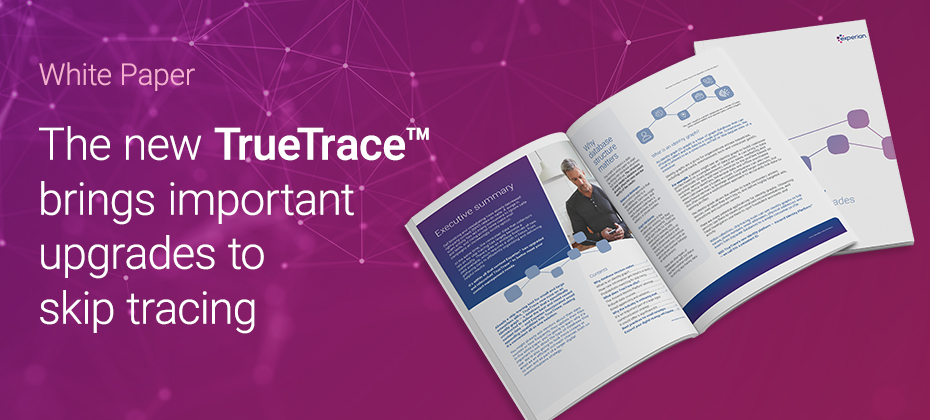Tag: data accuracy

In today's fast-paced world, the ability to locate individuals quickly and accurately is crucial for debt collectors and lenders. Leading skip tracing software is differentiated by data accuracy and data source expansion that delivers increased right-party contact (RPC) rates, better cost efficiency, and improved user experience. The need for improved skip tracing The landscape of skip tracing has changed dramatically in recent years. Call blocking and mislabeling have led to a decline in RPC rates, while increased scam activity has caused many consumers to ignore calls and texts. Additionally, the sheer volume of new information available makes efficiently organizing and delivering helpful results a higher priority than simply gathering data. Here are a few quick stats: Email addresses go stale at a rate of 3% each month There are 820 million changes across all contact databases every 90 days Human errors lead to 50% of data issues, such as a typo that results in a bounced email[1] As a result, we’ve made significant improvements to our skip tracing solution, TrueTrace™. What is TrueTrace? TrueTrace, a powerful skip tracing solution, is a go-to resource for both small and enterprise collectors. For locating hard-to-find individuals, TrueTrace is now even more effective, leveraging advanced technology and more data to enhance its performance. Some organizations that tested TrueTrace saw a 10% lift in RPC rates compared to the competition.[2] Here’s a look at some of the improvements we’ve made: Enhanced data accuracy: TrueTrace now runs on an identity graph to tie data from disparate sources to a unique persistent ID for each consumer. This upgrade improves data matching and accuracy, ensuring that users can rely on the information provided. Expanded data sources: The new version of TrueTrace incorporates email appending, making it a convenient all-in-one solution. By including new and unique data sources, TrueTrace increases hit rates and provides more quality results. With these improvements, here are some potential benefits to your business: Increased RPC rates: Improved data quality and accuracy lead to higher RPC rates, making it easier for collectors to reach the right individuals. Cost efficiency: Reducing operational costs associated with wrong-party contacts and outdated information helps businesses save money and improve their bottom line. Improved user experience: Easier access to accurate data leads to more efficient operations and a better overall user experience. Using an identity graph to organize data points Identity graphs allow organizations to build customer profiles based on a combination of data points. Companies can also use cloud-based services to implement additional, larger sets of data. Within an outreach strategy, skip tracing tools can use identity graphs to associate names, phone numbers, email address, physical address, and assets from multiple, unrelated databases into a single source of accurate information. This can help organizations save time and increase efficiency. Upgrades to skip tracing help businesses enhance efficiency The latest enhancements to TrueTrace represent a significant advancement in skip tracing technology. With upgraded data accuracy, expanded data sources, real-time updates, and flexible integration, TrueTrace offers a comprehensive solution for businesses looking to improve their outreach strategy. This tool can help businesses achieve higher RPC rates, reduce costs, and enhance their overall operational efficiency. To learn more about TrueTrace and its new features, read our latest whitepaper or visit our website or contact us for further inquiries. Discover how TrueTrace can help your business achieve better skip tracing with higher quality results today. Read the whitepaper Visit our website [1] Experian (2023). Revolutionizing your email strategy. [2] Experian TrueTrace data

This article was updated on February 21, 2024. With the rise of technology and data analytics in the financial industry today, it's no longer enough for companies to rely solely on traditional marketing methods. Data-driven marketing insights provide a more sophisticated and comprehensive view of shifting customer preferences and behaviors. With this in mind, this blog post will highlight the importance of data-driven marketing insights, particularly for financial institutions. The importance of data-driven marketing insights 30% of companies say poor data quality is a key challenge to delivering excellent customer experiences. Today’s consumers want personalized experiences built around their individual needs and preferences. Data-driven marketing insights can help marketers meet this demand, but only if it is fresh and accurate. When extending firm credit offers to consumers, lenders must ensure they reach individuals who are both creditworthy and likely to respond. Additionally, their message must be relevant and delivered at the right time and place. Without comprehensive data insights, it can be difficult to gauge whether a consumer is in the market for credit or determine how to best approach them. READ: Case study: Deliver timely and personalized credit offers The benefits of data-driven marketing insights By drawing data-driven marketing insights, you can reach and engage the best customers for your business. This means: Better understanding current and potential customers To increase response and conversion rates, organizations must identify high-propensity consumers and create personalized messaging that resonates. By leveraging customer data that is valid, fresh, and regularly updated, you’ll gain deeper insights into who your customers are, what they’re looking for and how to effectively communicate with them. Additionally, you can analyze the performance of your campaigns and better predict future behaviors. Utilizing technology to manage your customer data With different sources of information, it’s imperative to consolidate and optimize your data to create a single customer view. Using a data-driven technology platform, you can break down data silos by collecting and connecting consumer information across multiple sources and platforms. This way, you can make data available and accessible when and where needed while providing consumers with a cohesive experience across channels and devices. Monitoring the accuracy of your data over time Data is constantly changing, so implementing processes to effectively monitor and control quality over time is crucial. This means leveraging data quality tools that perform regular data cleanses, spot incomplete or duplicated data, and address common data errors. By monitoring the accuracy of your data over time, you can make confident decisions and improve the customer experience. Turning insights into action With data-driven marketing insights, you can level up your campaigns to find the best customers while decreasing time and dollars wasted on unqualified prospects. Visit us to learn more about how data-driven insights can power your marketing initiatives. Learn more Enhance your marketing strategies today This article includes content created by an AI language model and is intended to provide general information.

The tax gap—the difference between what taxpayers should pay and what they actually pay on time—can have a substantial impact on states’ budgets. Tax agencies and other state departments are responsible for helping states manage their budgets by minimizing expected revenue shortfalls. Underreported income is a significant budget complication that continues to frustrate even the most effective tax agencies, until the right tools are brought into play. The Problem Underreporting is a large, complex issue for agencies. The IRS currently estimates the annual tax gap at $441 billion. There are multiple factors that comprise that total, but the most prevalent is underreporting, which represents 80% of the total tax gap. Of that, 54% is due to underreporting of individual income tax. In addition to being the largest contributor to the tax gap, underreporting is also extremely challenging to identify out of the millions of returns being filed. With 85% of taxes owed correctly reported and paid, finding underreporting can be like trying to locate a needle in the proverbial haystack. Making this even more challenging is the limited resources available for auditing returns, which makes efficiency key. The Solution Data, combined with artificial intelligence (AI) equals efficient detection. The problem with trying to detect which returns are most likely to have underreported income is similar to many other challenges Experian has solved with AI. Partnerships between Experian and state agencies combine what we know about consumers with what their agency knows about their population. We can take the data and use AI to separate the signal from the noise, finding opportunities to recoup lost revenue. Read our case study on how Experian was able to help an agency identify instances of underreporting, detecting an estimated $80 million annual lost revenue from underreported income. Download case study Contact us

In today’s digital-first environment, fraud threats are growing in sophistication and scope. It’s critical for credit unions to not only understand the specific threats presented by life online, but to also be prepared with a solid fraud detection and prevention plan. Below, we’ve outlined a few fraud trends that credit unions should be aware of and prepared to address. 2021 Trends to Watch: Digitization and the Movement to Life Online Trend #1: Digital Acceleration As we look ahead to the rest of 2021 and beyond, we expect to see adoption of digital strategies nearing the top of credit unions’ list of priorities. Members’ expectations for their digital experience have permanently shifted, and many credit unions now have members using online channels who traditionally wouldn’t have. This has led to a change in the types of fraud we see as online activities increased in volume. Trend #2: First-Party Fraud is On the Rise First party fraud is on the rise – 43% of financial executives say that mule activity is up 10% or more compared to attack rates prior to the pandemic, according to Trace Fooshee, Senior Analyst for Aite Group, and we expect to see this number grow. The ability for credit unions to identify and segregate the “good guys” from “bad guys” is getting more difficult to discern and this detail is more important than ever as credit unions work to create frictionless digital experiences by using digital tools and strategies. Trend #3: Continual Uptick in Synthetic Identity Fraud We expect synthetic identity fraud (SID) to continue to rise in 2021 as cybercriminals become more sophisticated in the digital space and as members continue with their new digital habits. Additionally, fraudsters can use SIDs to bring significant damage and loss to credit unions through fraudulent checks, debit cards, person-to-person and automated clearing house (ACH) transactions. More and more, fraudsters are seen opening accounts and remaining very patient – using an account to build and nurture a trusted relationship with the credit union and then remain dormant for two years before ensuing in any sort of abuse. Once the fraudster feels confident that they can bypass authentication processes or avoid a new product vetting, oftentimes, they will take that opportunity to get easy access to all solutions credit unions have available and will abuse them all at once. There are no signs of fraud slowing, so credit unions will need to stay vigilant in their fraud protection and prevention plans. We’ve outlined a few tips for credit unions to help protect member data while reducing risk. The Fight Against Fraud: Four Key Tips Tip #1: Manage Each Fraud Type Appropriately Preventing and detecting fraud requires a multi-level solution. This can involve new methods for authenticating current and prospective members, as well as incorporating synthetic identity services and identity proofing throughout the member lifecycle. For example, credit unions should consider taking extra verification steps during the account opening process as a preventative measure to minimize SID infiltration and associated fraud losses. As credit unions continue down the path of digitization, it’s also important to add in digital signals and behavior-based verification, such as information about the device a consumer is logging in from to heighten defenses against bad actors. Tip #2: Be Resourceful In the wake of the COVID-19 pandemic, many have asked, “How should credit unions approach fraud prevention tactics when in-person contact is limited or unavailable?” In some cases, you might need to be willing to say no to requests or get creative and find other options. Sometimes, it takes leveraging current resources and using what’s readily available to allow for a binary decision tree. For example, if you’re suspicious of a dormant account that you think could be synthetic, call them, and ask yourself these questions: Did they answer? Was the phone still active? Send the account holder an email – did you get a reply? Is this a new member? Is this a new channel for the member? Could they have logged on to do this instead of calling the call center? Tip #3: Empower Members Through Education Members like to know that their credit unions are taking the necessary steps and applying the right measures to keep their data secure. While members might not want every detail, they do want to know that the security measures are there. Require the use of strong passwords, step-up authentication, and empower members with alerts, notifications, and card controls. Additionally, protect members by providing resources like trainings, webinars, and best practices articles, where they can learn about current cyber trends and how to protect their data. Tip #4: Trust Data Many credit unions rely on an employee’s decision to decide when to take action and what action to take. The challenge with this approach comes when the credit union needs to reduce friction for members or tighten controls to prevent fraud, because it’s extremely hard to know exactly what drove prior actions. A better alternative is to rely on scores and specific data. Tweaks to the scores or data points that drive actions allow credit unions to achieve the desired member experience and risk tolerance – just be sure to leverage internal experts help figure out those policies. By determining what conditions drive actions before the actions are taken (instead of doing it one case at a time) the decisions remain transparent and actionable. Looking for more insights around how to best position your credit union to mitigate and prevent fraud? Watch our webinar featuring experts from around the industry and key credit unions in this Fraud Insight Form hosted by CUES. Watch now Contact us

The ongoing COVID-19 crisis and the associated rise in online transactions have made it more important than ever to keep customer information accurate and company databases up to date. By ensuring your organization’s data quality, you can allocate resources more effectively, minimize costs and safely serve your customers. As part of our recently launched Q&A perspective series, Suzanne Pomposello, Experian’s Strategic Account Director for CEM vertical markets, and William Palmer, Senior Sales Engineer, provided insight on how utility providers can manage and maintain accurate client data during system migrations and modernizations, achieve a single customer view and implement an operational data quality program. Check out what they had to say: Q: What are the best practices for effective data quality management that utility providers should follow? SP: To ensure data quality, we advise starting with a detailed understanding of the data your organization is currently maintaining and how new data entering your systems is being utilized. Conducting a baseline assessment and being able to properly validate the accuracy of your data is key to identifying areas that require cleansing and enrichment. Once you know what improvements and corrections need to be made, you can establish a strategy that will empower your organization to unlock the full potential of your data. Q: How does Experian help clients improve their data hygiene? SP: Experian has over 30 years of expertise in data cleansing, which is tapped to help clients deploy tactics and strategies to ensure an acceptable level of data integrity. First, we obtain a complete picture of each organizations objectives and challenges. We then assess the quality of their data and identify sources that require remediation. Armed with insight, we work alongside organizations to develop a phased action plan to standardize and enhance their data. Our data management solutions satisfy a wide range of needs and can be consumed in real-time, bulk and batch form. Q: Are there any protection regulations to be aware of when obtaining updated data? WP: Unlike Experian’s regulated divisions, most Experian Data Quality data elements are not burdened by complex regulations and restrictions. Our focus is on organizations’ main customer data points (e.g., address, email address and phone). We reference this data against unregulated source systems to validate, append and complete customer profiles. Experian’s data quality management tools can serve as a foundation for many regulatory, compliance and governance requirements, including, Metro 2 reporting, TCPA and CCPA. Q: Are demos of Experian’s data management solutions available? If so, where can they be accessed? WP: Yes, you can visit our website to view product functionality clips and recorded demonstrations. Additionally, we welcome the opportunity to explore our comprehensive data quality management tools via tests and live demonstrations using actual client data to gain a better understanding of how our solutions can be used to improve operational efficiency and the customer experience. For more insight on how to cleanse, standardize, and enhance your data to make sure you get the most out of your information, watch our Experian Symposium Series event on-demand. Watch now Learn more About Our Experts: Suzanne Pomposello, Strategic Account Director, Experian Data Quality, North America Suzanne manages the energy vertical for Experian’s Data Quality division, supporting North America. She brings innovative solutions to her clients by leveraging technology to deliver accurate and validated contact data that is fit for purpose. William Palmer, Senior Sales Engineer, Experian Data Quality, North America William is a Senior Sales Engineer for Experian’s Data Quality division, supporting North America. As an expert in the data quality space, he advises utility clients on strategies for immediate and long-term data hygiene practices, migrations and reporting accuracy.

Article written by Alex Lintner, Experian's Group President of Consumer Information Services and Sandy Anderson, Experian's Senior Vice President of Client and Sales Operations Many consumers are facing financial stress due to unemployment and other hardships related to the COVID-19 pandemic. Not surprisingly, data scientists at Experian are looking into how consumers’ credit scores may be impacted during the COVID-19 national emergency period as financial institutions and credit bureaus follow guidance from financial regulators and law established in Section 4021 of the Coronavirus Aid, Relief, and Economic Security Act (CARES Act). In a nutshell, Experian finds that if consumers contact their lenders and are granted an accommodation, such as a payment holiday or forbearance, and lenders report the accommodation accordingly, consumer scores will not be materially affected negatively. It’s not just Experian’s findings, but also those of the major credit scoring companies, FICO® and VantageScore®. FICO has reported that if a lender provides an accommodation and payments are reported on time consistent with the CARES Act, consumers will not be negatively impacted by late payments related to COVID-19. VantageScore® has also addressed this issue and stated that its models are designed to mitigate the impact of missed payments from COVID-19. At the same time, if as predicted, lenders tighten underwriting standards following 11 consecutive years of economic growth, access to credit for some consumers may be curtailed notwithstanding their score because their ability to repay the loan may be diminished. Regulatory guidance and law provide a robust response Recently, the Federal Reserve, along with the federal and state banking regulators, issued a statement encouraging mortgage servicers to work with struggling homeowners affected by the COVID-19 national emergency by allowing borrowers to defer mortgage payments up to 180-days or longer. The Federal Deposit Insurance Corporation stated that financial institutions should “take prudent steps to assist customers and communities affected by COVID-19.” The Office of the Comptroller of the Currency, which regulates nationally chartered banks, encouraged banks to offer consumers payment accommodations to avoid delinquencies and negative credit bureau reporting. This regulatory guidance was backed by Congress in passing the CARES Act, which requires any payment accommodations to be reported to a credit bureau as “current.” The Consumer Financial Protection Bureau, which has oversight of all financial service providers, reinforced the regulatory obligation in the CARES Act. In a statement, the Bureau said “the continuation of reporting such accurate payment information produces substantial benefits for consumers, users of consumer reports and the economy as a whole.” Moreover, the consumer reporting industry has a history of successful coordination during emergency circumstances, like COVID-19, and we’ve provided the support necessary for lenders to report accurately and consistent with regulatory guidance. For example, when a consumer faces hardship, a lender can add a code that indicates a customer or borrower has been “affected by natural or declared disaster.” If a lender uses this or a similar code, a notification about the disaster or other event will appear in the credit report with the trade line for the customer’s account and will remain on the trade line until the lender removes it. As a result, the presence of the code will not negatively impact the consumer credit score. However, other factors may impact a consumer’s score, such as an increase in a consumer’s utilization of their credit lines, which is a likely scenario during a period of financial stress. Suppression or Deletion of late payments will hurt, not help, credit scores In response to the nationwide impact of COVID-19, some lawmakers have suggested that lenders should not report missed payments or that credit bureaus should delete them. The presumption is that these actions would hold consumers harmless during the crisis caused by this pandemic. However, these good intentions end up having a detrimental impact on the whole credit ecosystem as consumer credit information is no longer accurately reflecting consumers’ specific situation. This makes it difficult for lenders to assess risk and for consumers to obtain appropriately priced credit. Ultimately, the best way to help is a consumer-specific solution, meaning one in which a lender reaches an accommodation with each affected individual, and accurately reflects that person’s unique situation when reporting to credit bureaus. When a consumer misses a payment, the information doesn’t end up on a credit report immediately. Most payments are monthly, so a consumer’s payment history with a financial institution is updated on a similar timeline. If, for example, a lender was required to suppress reporting for three months during the COVID-19 national emergency, the result would be no data flowing onto a credit report for three months. A credit report would therefore show monthly payments and then three months of no updates. The same would be true if a credit reporting agency were required to suppress or delete payment information. The lack of data, due to suppression or deletion, means that lenders would be blinded when making credit decisions, for example to increase a credit limit to an existing customer or to grant a new line of credit to a prospective customer. When faced with a blind spot, and unable to assess the real risk of a consumer’s credit history, the prudential tendency would be to raise the cost of credit, or to decrease the availability of credit, to cover the risk that cannot be measured. This could effectively end granting of credit to new customers, further stifling economic recovery and consumer financial health at a time when it’s needed most. Beyond the direct impact on consumers, suppression or deletion of credit information could directly affect the safety and soundness of the nation’s consumer and small business lending system. With missing data, lenders and their regulators would be flying blind as to the accurate information about a consumer’s risk and could result in unknowingly holding loan portfolios with heightened risk for loss. Too many unexpected losses threaten the balance of the financial system and could further seize credit markets. Experian is committed to helping consumers manage their credit and working with lenders on how best to report consumer-specific solutions. To learn more about what consumers can do to manage credit during the COVID-19 national emergency, we’ve provided resources on our website. For individuals looking to explore options their lenders may offer, we’ve included links to many of the companies and update them continuously. With good public policy and consumer-specific solutions, consumers can continue to build credit and help our economy grow.

Earlier this year, the Consumer Financial Protection Bureau (CFPB) issued a Notice of Proposed Rulemaking (NPRM) to implement the Fair Debt Collection Practices Act (FDCPA). The proposal, which will go into deliberation in September and won't be finalized until after that date at the earliest, would provide consumers with clear-cut protections against disturbance by debt collectors and straightforward options to address or dispute debts. Additionally, the NPRM would set strict limits on the number of calls debt collectors may place to reach consumers weekly, as well as clarify how collectors may communicate lawfully using technologies developed after the FDCPA’s passage in 1977. So, what does this mean for collectors? The compliance conundrum is ever present, especially in the debt collection industry. Debt collectors are expected to continuously adapt to changing regulations, forcing them to spend time, energy and resources on maintaining compliance. As the most recent onslaught of developments and proposed new rules have been pushed out to the financial community, compliance professionals are once again working to implement changes. According to the Federal Register, here are some key ways the new regulation would affect debt collection: Limited to seven calls: Debt collectors would be limited to attempting to reach out to consumers by phone about a specific debt no more than seven times per week. Ability to unsubscribe: Consumers who do not wish to be contacted via newer technologies, including voicemails, emails and text messages must be given the option to opt-out of future communications. Use of newer technologies: Newer communication technologies, such as emails and text messages, may be used in debt collection, with certain limitations to protect consumer privacy. Required disclosures: Debt collectors will be obligated to send consumers a disclosure with certain information about the debt and related consumer protections. Limited contact: Consumers will be able to limit ways debt collectors contact them, for example at a specific telephone number, while they are at work or during certain hours. Now that you know the details, how can you prepare? At Experian, we understand the importance of an effective collections strategy. Our debt collection solutions automate and moderate dialogues and negotiations between consumers and collectors, making it easier for collection agencies to reach consumers while staying compliant. Powerful locating solution: Locate past-due consumers more accurately, efficiently and effectively. TrueTraceSM adds value to each contact by increasing your right-party contact rate. Exclusive contact information: Mitigate your compliance risk with a seamless and unparalleled solution. With Phone Number IDTM, you can identify who a phone is registered to, the phone type, carrier and the activation date. If you aren’t ready for the new CFPB regulation, what are you waiting for? Learn more Note: Click here for an update on the CFPB's proposal.

Have you seen the latest Telephone Consumer Protection Act (TCPA) class action lawsuit? TCPA litigations in the communications, energy and media industries are dominating the headlines, with companies paying up to millions of dollars in damages. Consumer disputes have increased more than 500 percent in the past five years, and regulations continue to tighten. Now more than ever, it’s crucial to build effective and cost-efficient contact strategies. But how? First, know your facts. Second, let us help. What is the TCPA? As you’re aware, TCPA aims to safeguard consumer privacy by regulating telephone solicitations and the use of prerecorded messages, auto-dialed calls, text messages and unsolicited faxes. The rule has been amended and more tightly defined over time. Why is TCPA compliance important? Businesses found guilty of violating TCPA regulations face steep penalties – fines range from $500 to $1500 per individual infraction! Companies have been delivered hefty penalties upwards of hundreds of thousands, and in some cases, millions of dollars. Many have questions and are seeking to understand how they might adjust their policies and call practices. How can you protect yourself? To help avoid risk for compliance violations, it’s integral to assess call strategies and put best practices in place to increase right-party contact rates. Strategies to gain compliance and mitigate risk include: Focus on right and wrong-party contact to improve customer service: Monitoring and verifying consumer contact information can seem like a tedious task, but with the right combination of data, including skip tracing data from consumer credit data, alternative and other exclusive data sources, past-due consumers can be located faster. Scrub often for updated or verified information: Phone numbers can continuously change, and they’re only one piece of a consumer’s contact information. Verifying contact information for TCPA compliance with a partner you can trust can help make data quality routine. Determine when and how often you dial cell phones: Or, given new considerations proposed by the CFPB, consider looking at collections via your consumers’ preferred communication channel – online vs. over the phone. Provide consumers user-friendly mechanisms to opt-out of receiving communications At Experian, our TCPA solutions can help you monitor and verify consumer contact information, locate past-due consumers, improve your right-party contact rates and automate your collections process. Get started

Financial institutions preparing for the launch of the Financial Accounting Standard Board’s (FASB) new current expected credit loss model, or CECL, may have concerns when it comes to preparedness, implications and overall impact. Gavin Harding, Experian’s Senior Business Consultant and Jose Tagunicar, Director of Product Management, tackled some of the tough questions posed by the new accounting standard. Check out what they had to say: Q: How can financial institutions begin the CECL transition process? JT: To prepare for the CECL transition process, companies should conduct an operational readiness review, which includes: Analyzing your data for existing gaps. Determining important milestones and preparing for implementation with a detailed roadmap. Running different loss methods to compare results. Once losses are calculated, you’ll want to select the best methodology based on your portfolio. Q: What is required to comply with CECL? GH: Complying with CECL may require financial institutions to gather, store and calculate more data than before. To satisfy CECL requirements, financial institutions will need to focus on end-to-end management, determine estimation approaches that will produce reasonable and supportable forecasts and automate their technology and platforms. Additionally, well-documented CECL estimations will require integrated workflows and incremental governance. Q: What should organizations look for in a partner that assists in measuring expected credit losses under CECL? GH: It’s expected that many financial institutions will use third-party vendors to help them implement CECL. Third-party solutions can help institutions prepare for the organization and operation implications by developing an effective data strategy plan and quantifying the impact of various forecasted conditions. The right third-party partner will deliver an integrated framework that empowers clients to optimize their data, enhance their modeling expertise and ensure policies and procedures supporting model governance are regulatory compliant. Q: What is CECL’s impact on financial institutions? How does the impact for credit unions/smaller lenders differ (if at all)? GH: CECL will have a significant effect on financial institutions’ accounting, modeling and forecasting. It also heavily impacts their allowance for credit losses and financial statements. Financial institutions must educate their investors and shareholders about how CECL-driven disclosure and reporting changes could potentially alter their bottom line. CECL’s requirements entail data that most credit unions and smaller lenders haven’t been actively storing and saving, leaving them with historical data that may not have been recorded or will be inaccessible when it’s needed for a CECL calculation. Q: How can Experian help with CECL compliance? JT: At Experian, we have one simple goal in mind when it comes to CECL compliance: how can we make it easier for our clients? Our Ascend CECL ForecasterTM, in partnership with Oliver Wyman, allows our clients to create CECL forecasts in a fraction of the time it normally takes, using a simple, configurable application that accurately predicts expected losses. The Ascend CECL Forecaster enables you to: Fulfill data requirements: We don’t ask you to gather, prepare or submit any data. The application is comprised of Experian’s extensive historical data, delivered via the Ascend Technology PlatformTM, economic data from Oxford Economics, as well as the auto and home valuation data needed to generate CECL forecasts for each unsecured and secured lending product in your portfolio. Leverage innovative technology: The application uses advanced machine learning models built on 15 years of industry-leading credit data using high-quality Oliver Wyman loan level models. Simplify processes: One of the biggest challenges our clients face is the amount of time and analytical effort it takes to create one CECL forecast, much less several that can be compared for optimal results. With the Ascend CECL Forecaster, creating a forecast is a simple process that can be delivered quickly and accurately. Q: What are immediate next steps? JT: As mentioned, complying with CECL may require you to gather, store and calculate more data than before. Therefore, it’s important that companies act now to better prepare. Immediate next steps include: Establishing your loss forecast methodology: CECL will require a new methodology, making it essential to take advantage of advanced statistical techniques and third-party solutions. Making additional reserves available: It’s imperative to understand how CECL impacts both revenue and profit. According to some estimates, banks will need to increase their reserves by up to 50% to comply with CECL requirements. Preparing your board and investors: Make sure key stakeholders are aware of the potential costs and profit impacts that these changes will have on your bottom line. Speak with an expert

I believe it was George Bernard Shaw that once said something along the lines of, “If economists were laid end-to-end, they’d never come to a conclusion, at least not the same conclusion.” It often feels the same way when it comes to big data analytics around customer behavior. As you look at new tools to put your customer insights to work for your enterprise, you likely have questions coming from across your organization. Models always seem to take forever to develop, how sure are we that the results are still accurate? What data did we use in this analysis; do we need to worry about compliance or security? To answer these questions and in an effort to best utilize customer data, the most forward-thinking financial institutions are turning to analytical environments, or sandboxes, to solve their big data problems. But what functionality is right for your financial institution? In your search for a sandbox solution to solve the business problem of big data, make sure you keep these top four features in mind. Efficiency: Building an internal data archive with effective business intelligence tools is expensive, time-consuming and resource-intensive. That’s why investing in a sandbox makes the most sense when it comes to drawing the value out of your customer data.By providing immediate access to the data environment at all times, the best systems can reduce the time from data input to decision by at least 30%. Another way the right sandbox can help you achieve operational efficiencies is by direct integration with your production environment. Pretty charts and graphs are great and can be very insightful, but the best sandbox goes beyond just business intelligence and should allow you to immediately put models into action. Scalability and Flexibility: In implementing any new software system, scalability and flexibility are key when it comes to integration into your native systems and the system’s capabilities. This is even more imperative when implementing an enterprise-wide tool like an analytical sandbox. Look for systems that offer a hosted, cloud-based environment, like Amazon Web Services, that ensures operational redundancy, as well as browser-based access and system availability.The right sandbox will leverage a scalable software framework for efficient processing. It should also be programming language agnostic, allowing for use of all industry-standard programming languages and analytics tools like SAS, R Studio, H2O, Python, Hue and Tableau. Moreover, you shouldn’t have to pay for software suites that your analytics teams aren’t going to use. Support: Whether you have an entire analytics department at your disposal or a lean, start-up style team, you’re going to want the highest level of support when it comes to onboarding, implementation and operational success. The best sandbox solution for your company will have a robust support model in place to ensure client success. Look for solutions that offer hands-on instruction, flexible online or in-person training and analytical support. Look for solutions and data partners that also offer the consultative help of industry experts when your company needs it. Data, Data and More Data: Any analytical environment is only as good as the data you put into it. It should, of course, include your own client data. However, relying exclusively on your own data can lead to incomplete analysis, missed opportunities and reduced impact. When choosing a sandbox solution, pick a system that will include the most local, regional and national credit data, in addition to alternative data and commercial data assets, on top of your own data.The optimum solutions will have years of full-file, archived tradeline data, along with attributes and models for the most robust results. Be sure your data partner has accounted for opt-outs, excludes data precluded by legal or regulatory restrictions and also anonymizes data files when linking your customer data. Data accuracy is also imperative here. Choose a big data partner who is constantly monitoring and correcting discrepancies in customer files across all bureaus. The best partners will have data accuracy rates at or above 99.9%. Solving the business problem around your big data can be a daunting task. However, investing in analytical environments or sandboxes can offer a solution. Finding the right solution and data partner are critical to your success. As you begin your search for the best sandbox for you, be sure to look for solutions that are the right combination of operational efficiency, flexibility and support all combined with the most robust national data, along with your own customer data. Are you interested in learning how companies are using sandboxes to make it easier, faster and more cost-effective to drive actionable insights from their data? Join us for this upcoming webinar. Register for the Webinar

If your company is like many financial institutions, it’s likely the discussion around big data and financial analytics has been an ongoing conversation. For many financial institutions, data isn’t the problem, but rather what could or should be done with it. Research has shown that only about 30% of financial institutions are successfully leveraging their data to generate actionable insights, and customers are noticing. According to a recent study from Capgemini, 30% of US customers and 26% of UK customers feel like their financial institutions understand their needs. No matter how much data you have, it’s essentially just ones and zeroes if you’re not using it. So how do banks, credit unions, and other financial institutions who capture and consume vast amounts of data use that data to innovate, improve the customer experience and stay competitive? The answer, you could say, is written in the sand. The most forward-thinking financial institutions are turning to analytical environments, also known as a sandbox, to solve the business problem of big data. Like the name suggests, a sandbox is an environment that contains all the materials and tools one might need to create, build, and collaborate around their data. A sandbox gives data-savvy banks, credit unions and FinTechs access to depersonalized credit data from across the country. Using custom dashboards and data visualization tools, they can manipulate the data with predictive models for different micro and macro-level scenarios. The added value of a sandbox is that it becomes a one-stop shop data tool for the entire enterprise. This saves the time normally required in the back and forth of acquiring data for a specific to a project or particular data sets. The best systems utilize the latest open source technology in artificial intelligence and machine learning to deliver intelligence that can inform regional trends, consumer insights and highlight market opportunities. From industry benchmarking to market entry and expansion research and campaign performance to vintage analysis, reject inferencing and much more. An analytical sandbox gives you the data to create actionable analytics and insights across the enterprise right when you need it, not months later. The result is the ability to empower your customers to make financial decisions when, where and how they want. Keeping them happy keeps your financial institution relevant and competitive. Isn’t it time to put your data to work for you? Learn more about how Experian can solve your big data problems. >> Interested to see a live demo of the Ascend Sandbox? Register today for our webinar “Big Data Can Lead to Even Bigger ROI with the Ascend Sandbox.”

Big Data is no longer a new concept. Once thought to be an overhyped buzzword, it now underpins and drives billions in dollars of revenue across nearly every industry. But there are still companies who are not fully leveraging the value of their big data and that’s a big problem. In a recent study, Experian and Forrester surveyed nearly 600 business executives in charge of enterprise risk, analytics, customer data and fraud management. The results were surprising: while 78% of organizations said they have made recent investments in advanced analytics, like the proverbial strategic plan sitting in a binder on a shelf, only 29% felt they were successfully using these investments to combine data sources to gather more insights. Moreover, 40% of respondents said they still rely on instinct and subjectivity when making decisions. While gut feeling and industry experience should be a part of your decision-making process, without data and models to verify or challenge your assumptions, you’re taking a big risk with bigger operations budgets and revenue targets. Meanwhile, customer habits and demands are quickly evolving beyond a fundamental level. The proliferation of mobile and online environments are driving a paradigm shift to omnichannel banking in the financial sector and with it, an expectation for a customized but also digitized customer experience. Financial institutions have to be ready to respond to and anticipate these changes to not only gain new customers but also retain current customers. Moreover, you can bet that your competition is already thinking about how they can respond to this shift and better leverage their data and analytics for increased customer acquisition and engagement, share of wallet and overall reach. According to a recent Accenture study, 79% of enterprise executives agree that companies that fail to embrace big data will lose their competitive position and could face extinction. What are you doing to help solve the business problem around big data and stay competitive in your company?

Many data furnishers are experiencing increases in dispute rates. It’s a tough spot to be in. Data furnishers are not only obligated under the FCRA to investigate and respond to all consumer disputes – reviewing every Automated Consumer Dispute Verification – but they must also do so within less than 30 days. As the number of disputes rise, resources become taxed and the risk of not meeting Fair Credit Reporting Act (FCRA) obligations increases. Let’s face it, consumer disputes aren’t going away, but understanding the reported data and metrics behind disputes can help data furnishers minimize them and defend reporting strategies and processes. 5 Way to Uncover Data Inaccuracy 1. Gain perspective against the industry and peers. Depending on the industry you service, the general benchmarks for dispute rates can vary. It’s important to understand where you fall in regards to dispute rates. Are you trending high or low? As an annualized average, we’ve recently experienced the following industry dispute rates through the end of the year: However, industry averages are just the tip of the iceberg. Measurement against peers can provide a clearer picture of where you fall. Are you an outlier or on par? How do you respond in comparison to peers? Are you deleting the trade as the result of the dispute at a higher rate? This could be an indicator of a systemic problem that needs addressing. 2. Implement pre-submission quality checks. Once you know where you stand, make sure your data is accurate before it heads out the door and hits the consumer’s credit report. Implement manual checks against Metro 2 rules. Build SQL queries to perform your checks. Better yet, use data validation software to automatically identify, track and remediate errors before sending the file to the bureaus. These steps can catch disputes before they happen. 3. Review any data being rejected after submission. Even if your new reporting motto is ‘know before it goes’; once the data has been transmitted, you’ll still want to monitor data being rejected due to Metro 2® errors. When data is rejected that means the update you provided did not make it to file. This leaves room for disputes. Incorporating a robust review of all rejected data in a timely and detailed manner, with updates made before the next reporting period, can improve the accuracy of your data. 4. Audit to identify and correct any stale data on file. An audit for any stale data - which includes open accounts with a balance greater than zero that have not been updated recently - should be performed at least annually. Review, research and remediate any outdated data that could affect your customer, making it susceptible to a dispute. 5. Educate your customers. Why are your customers disputing? Are there common themes within your customer base? Often, a dispute can be eliminated before it happens, with some explanation on the way an account is reported. By providing proactive access to materials and resources that help demystify the credit reporting process, a potentially negative interaction can be turned into a positive learning opportunity, helping the overall customer experience. Learn more about data accuracy solutions.

It’s been a wild ride for the financial services industry over the past eight years. After the mortgage meltdown, the Great Recession and a stagnant economy … well, one could say the country had seen better days. Did you watch The Big Short last winter? It all came crumbling down. And then President Barack Obama entered the scene. Change was needed. More oversight introduced. Suddenly, we had the Affordable Care Act, the Dodd-Frank Wall Street Reform Act and the creation of the Consumer Financial Protection Bureau (CFPB). Taxes were raised on the country’s highest earners for the first time since the late-1990s. In essence, the pendulum swung hard and fast to a new era of tightened and rigorous regulation. Fast forward to present day and we find ourselves on the cusp of transitioning to new leadership for the country. A new president, new cabinet, new leaders in Congress. What will it all mean for financial services regulations? It’s helpful to initially take a look back at the key regulations that have been introduced over the past eight years. Mortgage Reform: Long gone are the days of obtaining a quick mortgage. New rules have required loan originators to verify and document the consumer’s income and assets, including employment status (if relied upon), existing debt obligations, mortgage-related obligations, alimony and child support. The CFPB has also expanded foreclosure protections for struggling borrowers and homeowners. Maintaining the health of the mortgage industry is important for the entire country, and updated rules have enhanced the safety and transparency of the mortgage market. Home values have largely recovered from the darkest days, but some question whether the underwriting criteria have become too strict. Combatting Fraud: The latest cyber-attack trends and threats come fast and furious. Thus, regulators are largely addressing the challenge by expecting banks to adhere to world-class standards from organizations such as the National Institute of Standards and Technology (NIST). The Federal Trade Commission (FTC) and the National Credit Union Administration (NCUA) implemented the Red Flags Rule in November 2008. It requires institutions to establish policies and procedures to identify and recognize red flags — i.e., patterns, practices or specific activities that indicate the possible existence of identity theft — that occur during account-opening activities, existing account maintenance and new activity on an account that has been inactive for two or more years. Loss Forecasting: The Dodd-Frank Act Requires the Federal Reserve to conduct an annual stress test of bank holding companies (BHCs), savings and loan holding companies, state member banks, and nonbank financial institutions. In October 2012, the Fed Board adopted the Comprehensive Capital Analysis and Review (CCAR) rules. This requires banks with assets of $50 billion or more to submit to an annual review centered on a supervisory stress test to gauge capital adequacy. In January 2016, Dodd-Frank Act Stress Testing (DFAST) was introduced, requiring bank holding companies with assets of $10 billion or more to conduct separate annual stress tests known as “company-run tests” using economic scenarios. Every year regulators expect to see continued improvement in stress-testing models and capital-planning approaches as they raise the bar on what constitutes an acceptable practice. CFPB: No longer the new kids on the block, the CFPB has transitioned to an entity that has its tentacles into every aspect of consumer financial products. Mortgage lending was one of their first pursuits, but they have since dug into “ability-to-pay underwriting” and servicing standards for auto loans, credit cards and add-on products sold through third-party vendors. Now they are looking into will likely be the next “bubble,” – student lending – and educating themselves about online marketplace lending. Data Quality: Expectations related to data quality, risk analytics, and regulatory reporting have risen dramatically since the financial downturn. Inaccuracy in data is costly and harmful, slows down the industry, and creates frustration. In short, it’s bad for consumers and the industry. It’s no secret that financial institutions rely on the accuracy of credit data to make the most informed decisions about the creditworthiness of their customers. With intense scrutiny in this area, many financial institutions have created robust teams to handle and manage requirements and implement sound policies surrounding data accuracy. --- This is merely a sliver of the multiple regulations introduced and strengthened over the past eight years. Is there a belief that the regulatory pendulum might take a swing to other side with new leadership? Unlikely. The agenda for 2017 largely centers on the need to improve debt collections practices, enhance access to credit for struggling Americans, and the need for ongoing monitoring of the fintech space. Only time will tell, but one thing is certain. Anyone involved in financial services needs to keep a watchful eye on the ever-evolving world of regulation and Washington.

What you give, you get. At least that is what popular philosophers claim. And if you think about it, this statement is also applicable to the world of data accuracy. As organizations of all sizes increasingly rely on data to interact with customers and create insights to drive strategy, it’s no secret bad data can quickly lead a company or financial institution down the wrong path, even landing them into regulatory troubles. A recent Experian Data Quality study found: Seventy-five percent of organizations believe inaccurate data is undermining their ability to provide an excellent customer experience. Sixty-five percent of organizations wait until there are specific issues with their data before they address and fix them. Fifty-six percent of organizations believe mistakes can be attributed to human error. For years, organizations have wanted good data simply for operational efficiencies and cost savings, but now a shift has taken place where businesses are using data for nearly every aspect of their organization. The majority of sales decisions are expected to be driven by customer data by 2020, with companies determined to turn data into actionable insight to find new customers, increase customer retention, better understand their needs, and increase the value of each customer. Additionally, the Fair Credit Reporting Act (FCRA) requires those contributing data to provide accurate and complete information to the credit reporting agencies. If they fail to meet accuracy obligations when reporting negative account histories to credit reporting companies, the result could be bureau action and fines. Organizations still deal with a high degree of inaccurate data because there are a number of challenges to maintaining it. Some of them are external forces, but many are internal challenges – most notably a reliance on reactive data management strategies. The biggest problem organizations face around data management today actually comes from within. Businesses get in their own way by refusing to create a culture around data and not prioritizing the proper funding and staffing for data management. Many businesses know they need to improve their data quality, but often have a hard time defining why an investment is needed in the current structure. Solutions exist to get in front of data accuracy challenges. DataArc 360 Powered by Experian Pandora, for example, is designed to check the consumer credit information provided by data furnishers prior to submission to credit bureaus. This allows data suppliers to take more of a proactive approach to ensuring the accuracy of information, that may result in fewer credit disputes and a more positive interaction between consumers and their credit. Creating a clear governance plan, and centralizing data management policies and policies can also clean up internal challenges and improve accuracy standards. The importance of data cannot be neglected, but again, the data has to be clean for it to matter. What you give is what you’ll get.